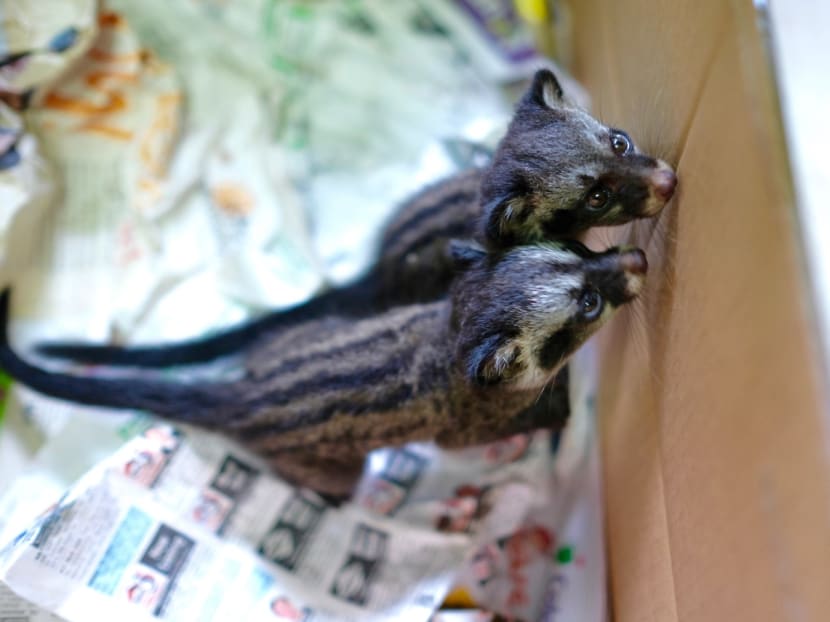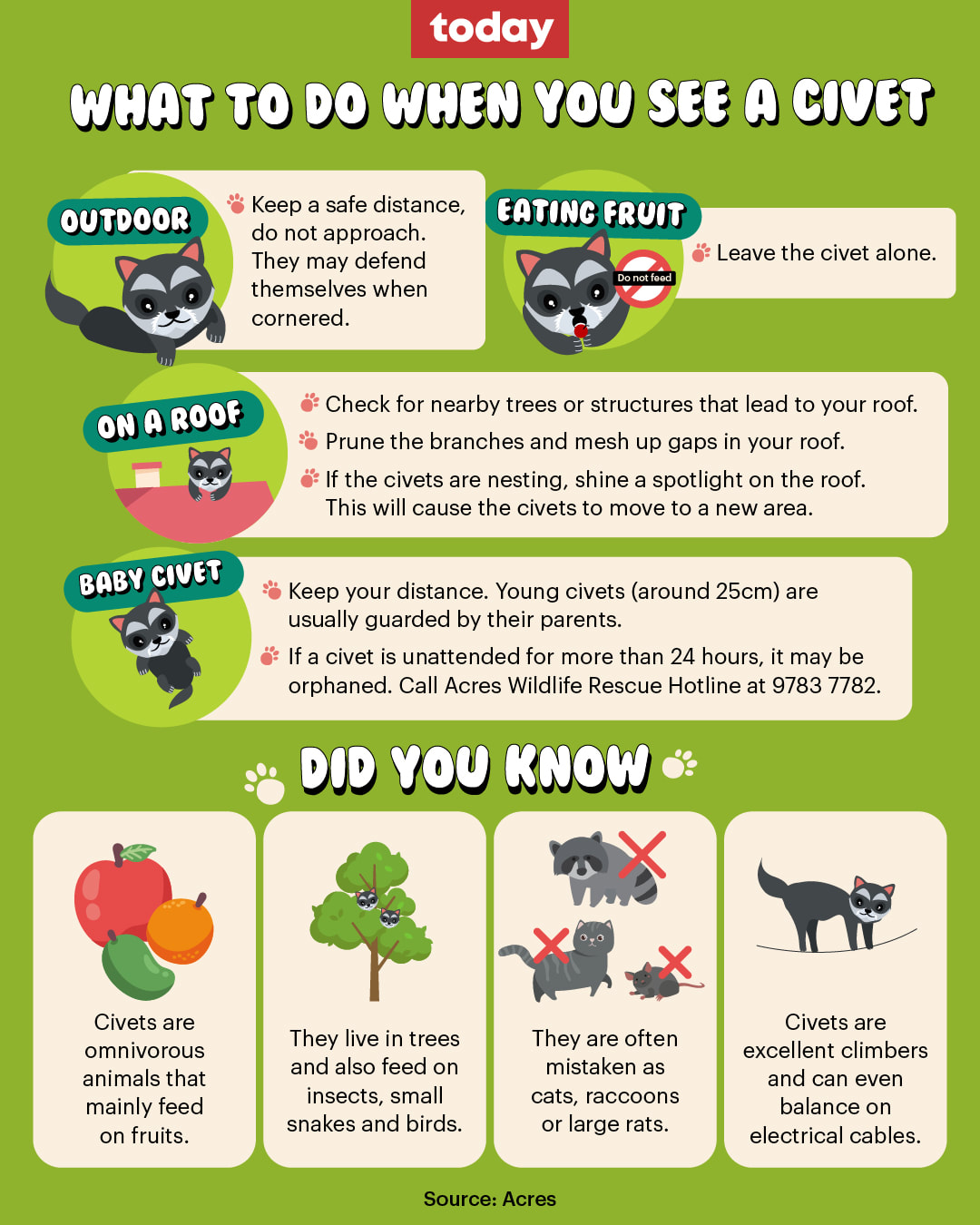Seen more civets in your neighbourhood recently? Experts say it could be a good thing
SINGAPORE – “Every night the civets play and fight in my ceiling… and they poop everywhere," said 83-year-old Mdm Tannie Tan, a resident of Jalan Chempaka Puteh, a neighbourhood in Bedok that has faced a civet issue for the last two years.

- Singapore has seen an increase in reports of civet sightings recently
- Many residents find the cat-sized mammal’s presence an annoyance at best, and destructive at worst
- But experts TODAY spoke to say that having civets in an area is a sign of a healthy ecosystem
- The authorities discourage residents from trapping and removing civets on their own and instead advise calling animal rescue hotlines for assistance
SINGAPORE – “Every night the civets play and fight in my ceiling… and they poop everywhere," said 83-year-old Mdm Tannie Tan, a resident of Jalan Chempaka Puteh, a neighbourhood in Bedok that has faced a civet issue for the last two years.
When asked about what problems the cat-sized mammal caused, Mdm Tan showed TODAY the damage to her house's roofing.
“I use a bamboo pole to poke the ceiling when I hear them in the ceiling to get them to run away,” she said.
Her neighbours, she added, installed spikes on their roof to stop civets from entering.
But as an animal lover who often feeds sparrows on her property, Mdm Tan never complained about the issue because she does not want to harm the animals.
“I don’t mind (the damage), because I can pay someone to fix it”.
Another Jalan Chempaka Puteh resident, who wanted to be known as Mr Lee, told TODAY that his family has had to turn on bright lights on the exterior of their property at night to keep about six to seven civets from entering the house.
“We don’t (attempt to trap) the civets, but some of my neighbours and in my community use cages to catch them and hand them over to the authorities,” the 67-year-old part-time private hire driver said.
Jalan Chempaka Puteh is one of several neighbourhoods that have seen an increase in civet sightings in recent years.
The Animal Concerns Research and Education Society (Acres) told TODAY that it received more than double the number of reports of civets in the last year, up to 15 to 20 reports every month, from six to nine per month previously in 2021.
Acres was unable to pinpoint any specific hot spots.

WHY THE INCREASE IN CIVET SIGHTINGS?
Nature experts TODAY spoke to said there are several reasons civets have been appearing in human spaces more often in recent years.
“The seemingly high encounter rates could be a combination of factors, which include increased awareness of local wildlife over the years, ease of reporting sightings on social media and also clearing of forest patches, which has led to civets dispersing out into nearby areas,” said Ms Xu Weiting, an instructor (ecology, evolution and biodiversity) at the National University of Singapore’s (NUS) Department of Biological Sciences.
Mr N Sivasothi, a senior lecturer from the same NUS department, added: “As greening and connectivity improve, we expect that they will be seen in more areas… (as civets) are adaptable and can make use of the semi-urban environment.”
They advised residents to turn to local organisations like the National Parks Board (NParks) and Acres for help with resolving civet-related problems.
“If you encounter a civet, do keep calm, observe from a safe distance, and do not corner or chase the animal,” advised Dr Adrian Loo, group director of wildlife management at NParks.
“Do call NParks’ Animal Response Centre at 1800-476-1600 if a civet is trapped in your house and unable to leave on its own, if the civet appears to be injured, or if you require further advice on civet-related issues.”
One concern that some residents have is that civets could be a host for zoonotic diseases.
The virus which caused the severe acute respiratory syndrome (Sars) outbreak which killed almost 800 people worldwide from 2002 to 2003, including 33 in Singapore, is believed to have jumped from bats to civets and then humans.
NParks maintains that the population of civets in Singapore is currently stable and that it regularly conducts biosurveillance on civets.
Biosurveillance involves the monitoring and management of animal diseases that may pose threats to human and animal health, it said.
Posters have also been put up at civet hot spots to educate residents on what to do when encountering a civet.
The public should refrain from trapping civets as removing the animal does not address the root cause of what attracted the civet to the property in the first place, said Acres co-chief executive officer Anbarasi Boopal.
“By removing the root cause, which could be either food availability or nesting space availability, that will deter them from entering our space,” she said.
CIVET SIGHTING IS A GOOD THING: EXPERTS
Though many residents have found the civets in their neighbourhoods to be a nuisance, experts told TODAY that their presence could be a sign of a healthy ecosystem in the area.
“Seeing civets is an indicator that that particular neighbourhood has fruit trees and greenery to support civets. And if they can support civets, then that would also mean that it can support birds and other kinds of urban nature there,” said Dr Shawn Lum, a senior lecturer at Nanyang Technological University's Asian School of Environment.
“So rather than seeing it as something to be dreaded, we should actually want to see civets.”
Mr Sivasothi said that people in Singapore used to be able to see many types of wildlife, but most of it disappeared with urbanisation.
“So now we are beginning to have a greener Singapore... And part of that is the joy of being able to see wildlife in our midst once again,” he said.
“But we've been out of contact (with wild animals) for so long, we now have to relearn how to coexist with the wildlife.”







